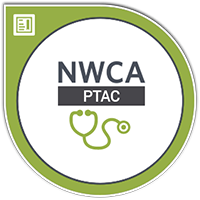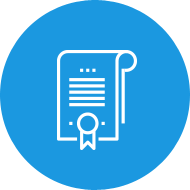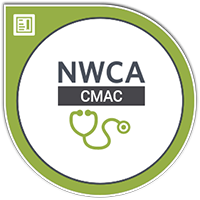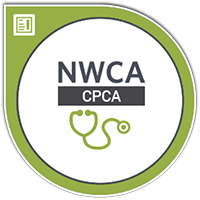The Clinical Medical Assisting online certification course from Condensed Curriculum International is designed to prepare students to function as professionals in multiple healthcare settings. Medical assistants with a clinical background perform various clinical tasks including assisting with the administration of medications and with minor procedures, performing an EKG electrocardiogram, obtaining laboratory specimens for testing, educating patients, and other related tasks. Job opportunities are prevalent with physician’s offices, clinics, chiropractor’s offices, hospitals and outpatient facilities.
This online program prepares learners to assist physicians by performing functions related to the clinical aspects of a medical office. Instruction includes preparing patients for examination and treatment, routine laboratory procedures, pharmacology, taking and documenting vital signs, technical aspects of phlebotomy, the 12-lead EKG and the cardiac life cycle. The purpose of the Clinical Medical Assisting certification course is to prepare learners to assist physicians by performing functions related to the clinical aspects of a medical office.
After completing this program, learners will be able to:
After completing this program, learners will have the option to take the leading national/industry-recognized certification exams essential to entry-level employment in this fast-growing field.
| National Healthcareer Association (NHA) Certified Clinical Medical Assistant (CCMA) |
Learners who complete this program are eligible to participate in an optional volunteer externship opportunity with a local company/agency/organization whose work aligns with this area of study in order to gain valuable hands-on experience. As learners progress through their eLearning program, an Externship Coordinator will reach out to coordinate placement.
Note: Additional documentation including health records, immunizations, drug-screening, criminal background checks, etc. may be required by the externship facility.
The need for Pharmacy Technicians continues to grow with demand expected to increase substantially through 2024. Technicians work under the supervision of a registered pharmacist in hospitals, home infusion pharmacies, community pharmacies and other healthcare settings. This high demand for pharmacy technicians is the result of a multitude of factors including the constant availability of new drugs, the national shortage of registered pharmacists, the establishment of certified pharmacy technicians, and the aging population. Approximately 400,000 technicians will be employed by the year 2024 to meet our nation’s growing healthcare demands.
This comprehensive course will prepare learners to enter the pharmacy field and take the Pharmacy Technician Certification Board’s PTCB exam. Content includes pharmacy terminology, reading and interpreting prescriptions, defining generic and brand names drugs, and much, much more. This program will prepare students to enter the pharmacy field and to pursue certification including the Pharmacy Technician Certification Board’s PTCB exam.
After completing this program, learners will be able to:
After completing this program, learners will have the option to take the leading national/industry-recognized certification exam(s) essential to entry-level employment in this fast-growing field.
 | Pharmacy Technician Certification Board (PTCB) Certified Pharmacy Technician (CPhT) |
 | National Workforce Career Association (NWCA) Pharmacy Technician Associate Certification (PTAC) |
Learners who complete this program are eligible to participate in an optional volunteer externship opportunity with a local company/agency/organization whose work aligns with this area of study in order to gain valuable hands-on experience. As learners progress through their eLearning program, an Externship Coordinator will reach out to coordinate placement.
Note: Additional documentation including health records, immunizations, drug-screening, criminal background checks, etc. may be required by the externship facility.
Medical billing and coding is one of the fastest-growing careers in the healthcare industry today! The need for professionals who understand how to code healthcare services and procedures for third-party insurance reimbursement is growing substantially. Physician practices, hospitals, pharmacies, long-term care facilities, chiropractic practices, physical therapy practices, and other healthcare providers all depend on medical billing and coding for insurance carrier reimbursement.
This billing and coding program offers the skills needed to perform complex coding and billing procedures. The program covers: CPT (Introduction, Guidelines, Evaluation and Management), specialty fields (such as surgery, radiology and laboratory), the ICD-10 for both diagnosis and procedure coding, and basic claims processes for insurance reimbursements. This billing and coding program delivers the skills learners need to solve insurance billing and coding problems. It details proper assignment of codes and the process to file claims for reimbursement.
After completing this program, learners will be able to:
After completing this program, learners will have the option to take the leading national/industry-recognized certification exam(s) essential to entry-level employment in this fast-growing field.
| National Healthcareer Association (NHA) Certified Billing & Coding Specialist (CBCS) |
Learners who complete this program are eligible to participate in an optional volunteer externship opportunity with a local company/agency/organization whose work aligns with this area of study in order to gain valuable hands-on experience. As learners progress through their eLearning program, an Externship Coordinator will reach out to coordinate placement.
Note: Additional documentation including health records, immunizations, drug-screening, criminal background checks, etc. may be required by the externship facility.
The phlebotomist is a vital member of the clinical laboratory team, whose main function is to obtain patient’s blood specimens by venipuncture and micro-collection for testing purposes. Phlebotomists are employed throughout the healthcare system including in hospitals, neighborhood health centers, medical group practices, HMO’s, public health facilities, veteran hospitals, insurance carriers, and in other healthcare settings. The demand for phlebotomy technicians has increased substantially with the overall complexity of healthcare services and the risks of infectious disease. Current healthcare industry experts predict a 15% increase in phlebotomy jobs by 2024.
This program prepares learners to collect blood specimens from clients for the purpose of laboratory analysis. Learners will become familiar with all aspects of blood collection and will review the skills needed to perform venipunctures safely. Topics in this course include medical terminology, related anatomy and physiology, blood collection procedures, and procedures for collection of other types of specimens within the scope of practice of the phlebotomist.
After completing this program, learners will be able to:
After completing this program, learners will have the option to take the leading national/industry-recognized certification exam(s) essential to entry-level employment in this fast-growing field.
| National Healthcareer Association (NHA) Phlebotomy Technician Certification (CPT) |
Learners who complete this program are eligible to participate in an optional volunteer externship opportunity with a local company/agency/organization whose work aligns with this area of study in order to gain valuable hands-on experience. As learners progress through their eLearning program, an Externship Coordinator will reach out to coordinate placement.
Note: Additional documentation including health records, immunizations, drug-screening, criminal background checks, etc. may be required by the externship facility.
Surgical technologists are members of the surgical team working under the supervision and authority of the surgeon within the scope of practice of state law and hospital policy. These surgical team members help prepare the operating room by setting up sterile surgical instruments, equipment, supplies, and medications. They check to ensure that all equipment is in the proper place and working properly. They also assist the surgeon in donning PPE as well as transport the patient to the OR, position and drape the patient for the specific procedure, prepare the skin for the procedure, and assist the surgeon as needed during the procedure. They must know medical terminology, anatomy, and physiology as well as the many different types of surgical instruments and equipment, proper infection control procedure, and effective communication strategies used with team members and the patient prior to and after the surgical procedure. This course provides an introduction to the surgical technologist career, role in the operating room, and foundational concepts.
After completing this program, learners will be able to:
CCI’s Surgical Tech Certificate Program is certified by both National Center for Competency Testing (NCCT) and American Allied Health (AAH). In addition to successfully completing the certification exam, certified candidates may be required to submit additional documentation to maintain certification. NCCT is a nationally accredited surgical technologist credentialing organization. After completing this program, learners will have the opportunity to take a certification exam(s) essential to entry-level employment in this fast-growing field.
 | American Allied Health (AAH) Surgical Technologist Certification |
 | Tech in Surgery TS-C (NCCT) Certification |
Disclaimer: This Surgical Technologist program is approved by the National Center for Competency Testing (NCCT) and American Allied Health (AAH). This is not an associate degree and/or Commission on Accreditation of Allied Health Education Programs (CAAHEP) – approved program, which requires a 1 to 2-year associate degree credit program. However, there are multiple employment opportunities for students in the following job titles including but not limited to:
Surgical Technician (ST)
Operating Room Assistant (ORA)
Surgical Scrub Technician (SST)
Peri-Operative Assistant (POA)
Endoscopy Technician (ET)
Prospective students are advised that CCI cannot guarantee that any particular employer will accept NCCT or AAH certification for employment purposes. Prior to enrolling students should determine whether NCCT and/or AAH certification is sufficient for the type of employment (and/or the employer) that the prospective student is seeking.
Learners who complete this program are eligible to participate in an optional volunteer externship opportunity with a local company/agency/organization whose work aligns with this area of study in order to gain valuable hands-on experience. As learners progress through their eLearning program, an Externship Coordinator will reach out to coordinate placement.
Note: Additional documentation including health records, immunizations, drug-screening, criminal background checks, etc. may be required by the externship facility.
EKG technicians are in demand! EKG technicians work in physician’s offices, hospitals, clinics, and other healthcare facilities and organizations. EKG technicians also work for insurance companies to provide data for health and life insurance policies. Similar to other growing healthcare professions, the demand for EKG technicians is expected to continue to grow substantially.
This program covers topics and processes critical to conducting and interpreting electrocardiograms (EKGs). To begin, learners will review the anatomy and physiology of the heart. From there, learners will go on to explore the technology used such as the EKG machine. Next, participants will learn how to interpret a rhythm strip. And finally, learners will discover the details of a myocardial infarction. Successful completion of this program will help prepare learners to perform the role of EKG technician.
After completing this program, learners will be able to:
After completing this program, learners will have the option to take the leading national/industry-recognized certification exam(s) essential to entry-level employment in this fast-growing field.
| National Healthcareer Association (NHA) Certified EKG Technician (CET) |
Learners who complete this program are eligible to participate in an optional volunteer externship opportunity with a local company/agency/organization whose work aligns with this area of study in order to gain valuable hands-on experience. As learners progress through their eLearning program, an Externship Coordinator will reach out to coordinate placement.
Note: Additional documentation including health records, immunizations, drug-screening, criminal background checks, etc. may be required by the externship facility.
The healthcare industry is currently undergoing major changes in the manner in which patient care is provided. In addition to medical assistants, this restructuring has resulted in the introduction of a new category of healthcare worker trained to perform a variety of patient care services. Patient Care Technicians possess the technical skills necessary to service complex patient personal care and medical assisting issues including the implementation of selected portions of a specific care plan that may include rehabilitation services, basic bedside care, collection of laboratory specimens, phlebotomy and EKG’s. They work alongside doctors, nurses, medical assistants, and other healthcare providers to oversee and monitor patients.
This Patient Care Technician program will provide you with the basic medical knowledge and hands on skills necessary to perform or obtain technical diagnostic testing and perform direct patient care.
After completing this program, learners will be able to:
After completing this program, learners will have the opportunity to take the leading national/industry-recognized certification exam(s) essential to entry-level employment in this fast-growing field.
 | National Workforce Career Association (NWCA) Clinical Medical Assistant Certification (CMAC) |
 | National Workforce Career Association (NWCA) Certified Personal Care Assistant (CPCA) |
Learners who complete this program are eligible to participate in an optional volunteer externship opportunity with a local company/agency/organization whose work aligns with this area of study in order to gain valuable hands-on experience. As learners progress through their eLearning program, an Externship Coordinator will reach out to coordinate placement.
Note: Additional documentation including health records, immunizations, drug-screening, criminal background checks, etc. may be required by the externship facility.
The Dental Assistant program prepares students for entry-level positions in one of the fastest growing healthcare professions. With the national increase in healthcare-related services, and the national shortage of healthcare professionals, the need for dental assistants is growing substantially. With a growing workforce over 300,000 strong, a career in dental assisting ranks as the fourth fastest growing occupation in the healthcare technician field.
The program prepares learners for entry-level positions as a chair-side dental assistant. This program covers the history of dentistry, introduction to the dental office, the legal aspects of dentistry, introduction to oral anatomy, dental operatory, introduction to tooth structure (primary and permanent teeth), the oral cavity; and other areas. The purpose of this program is to familiarize learners with all areas of administrative and clinical dental assisting focusing on the responsibilities required to function as an assistant in a dental practice.
After completing this program, learners will be able to:
After completing this program, learners will have the option to take the leading national/industry-recognized certification exam(s) essential to entry-level employment in this fast-growing field.
 | Dental Assisting National Board (DANB) Radiation Health and Safety (RHS) |
 | National Workforce Career Association (NWCA) Dental Assistant Clinical Certification (DACC) |
Learners who complete this program are eligible to participate in an optional volunteer externship opportunity with a local company/agency/organization whose work aligns with this area of study in order to gain valuable hands-on experience. As learners progress through their eLearning program, an Externship Coordinator will reach out to coordinate placement.
Note: Additional documentation including health records, immunizations, drug-screening, criminal background checks, etc. may be required by the externship facility.